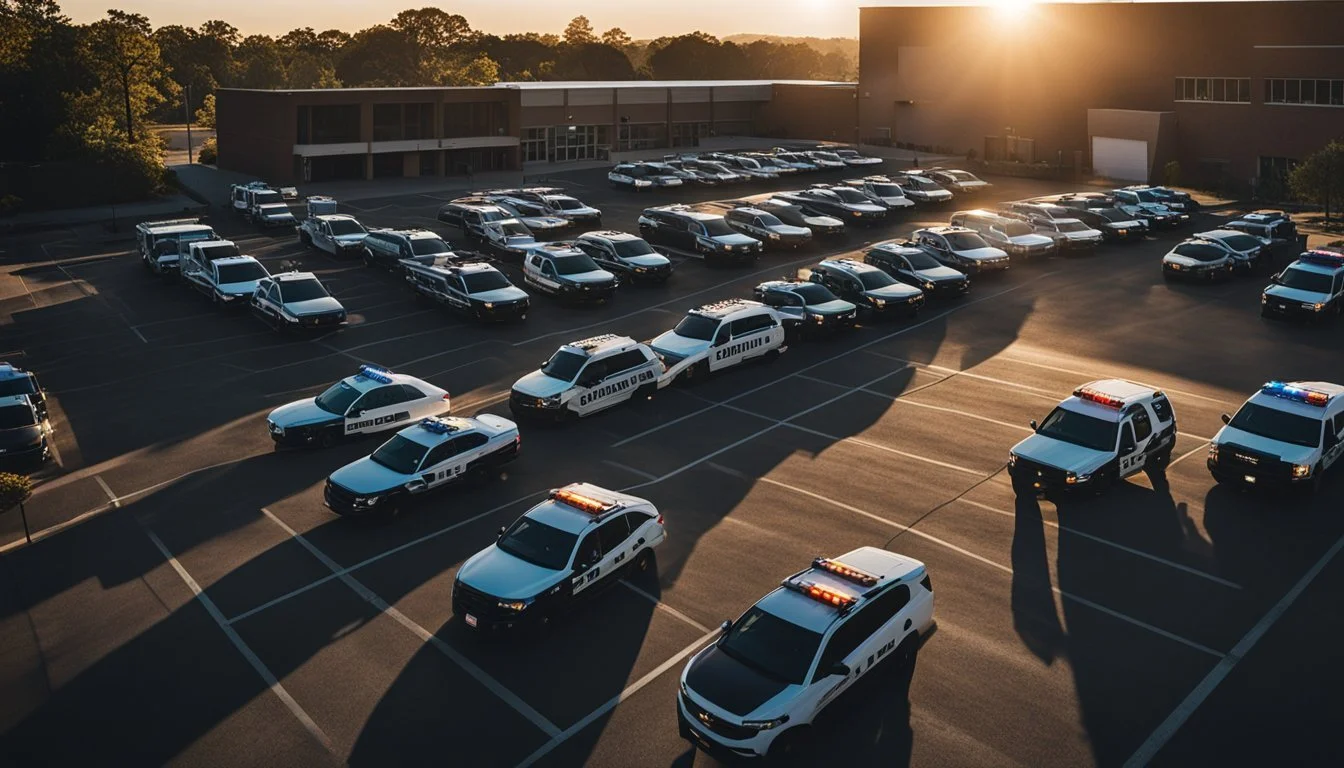Haunting Documentaries Explore the Legacy of Columbine
The Columbine High School shooting of 1999 shocked the nation and left an indelible mark on American society. This tragic event has been the subject of numerous documentaries over the years, each offering unique perspectives and insights into the factors surrounding the massacre.
Documentaries about Columbine explore various aspects of the shooting, including the perpetrators' motivations, the impact on survivors and families, and broader societal issues related to gun violence and school safety. These films serve as important historical records, providing viewers with a deeper understanding of this pivotal moment in recent history and its lasting effects on communities across the United States.
1) Bowling for Columbine (2002)
Michael Moore's documentary "Bowling for Columbine" examines gun violence in America, using the Columbine High School shooting as a focal point. The film explores potential causes of gun-related tragedies and questions prevailing attitudes towards firearms.
Moore interviews various individuals, including celebrities, gun enthusiasts, and survivors of gun violence. He investigates the role of media, fear, and societal factors in shaping America's gun culture.
The documentary draws comparisons between the United States and other countries, particularly Canada, to highlight differences in gun violence rates. Moore also examines the influence of the National Rifle Association and the weapons manufacturing industry.
"Bowling for Columbine" garnered critical acclaim and won the Academy Award for Best Documentary Feature. It sparked debates about gun control and violence in American society.
The film's title refers to the bowling class taken by the Columbine shooters on the morning of the massacre. Moore uses this fact to challenge simplistic explanations for such tragedies.
2) Zero Hour: Massacre at Columbine High (2004)
Zero Hour: Massacre at Columbine High offers a minute-by-minute account of the tragic events that unfolded at Columbine High School on April 20, 1999. The documentary meticulously reconstructs the timeline of the massacre carried out by Eric Harris and Dylan Klebold.
The film provides insights into the backgrounds of the perpetrators and explores potential motives behind their actions. It includes interviews with survivors, witnesses, and law enforcement officials involved in the case.
Using a combination of reenactments and archival footage, Zero Hour creates a vivid portrayal of the panic and confusion that gripped the school during the attack. The documentary also examines the immediate aftermath and long-term impact of the tragedy on the community.
Zero Hour: Massacre at Columbine High serves as a sobering reminder of the devastating consequences of school violence. It offers a comprehensive look at one of the most infamous mass shootings in American history.
3) American Tragedy (2019)
American Tragedy offers a unique perspective on the Columbine shooting by focusing on Sue Klebold, mother of Dylan Klebold, one of the shooters. The documentary explores her journey of grief, guilt, and understanding in the aftermath of the tragedy.
Directed by Josh Sabey, the film delves into Sue's efforts to comprehend her son's actions and her advocacy for mental health awareness. It features intimate interviews with Sue and provides insight into the Klebold family's experiences before and after the shooting.
The documentary examines the complex emotions Sue grapples with as she tries to reconcile the loving son she knew with the person who committed such a horrific act. It also highlights her work in suicide prevention and her attempts to find meaning in the tragedy.
American Tragedy offers a thought-provoking look at the long-term impact of the Columbine shooting on the families of the perpetrators. It challenges viewers to consider the broader implications of such events and the importance of mental health support.
More information on American Tragedy
4) Columbine: Wounded Minds
"Columbine: Wounded Minds" is an unreleased documentary project initiated by Sam Granillo, a survivor of the 1999 Columbine High School shooting. Granillo began production on the film to explore the long-term psychological effects of the tragedy on survivors.
The documentary aims to bring attention to the ongoing struggles faced by those impacted by the Columbine shooting. It focuses on the mental health challenges and coping mechanisms of survivors in the years following the event.
Granillo's project seeks to provide a platform for survivors to share their experiences and highlight the importance of continued support for victims of mass shootings. The film intends to shed light on the lasting trauma and its impact on individuals' lives.
While "Columbine: Wounded Minds" remains unreleased, it has garnered interest from those seeking to understand the long-term consequences of such traumatic events. The project emphasizes the need for ongoing mental health resources and support for survivors of mass shootings.
5) Killing Spree: Columbine High
"Killing Spree: Columbine High" (2007) examines the tragic events at Columbine High School on April 20, 1999. The documentary focuses on Eric Harris and Dylan Klebold, the two students responsible for the massacre.
The film provides a detailed timeline of the attack, using survivor accounts and police reports to reconstruct the events. It explores the shooters' backgrounds and possible motivations, drawing from their personal journals and video recordings.
Experts analyze the psychological factors that may have contributed to the teens' actions. The documentary also examines the impact of the shooting on the community and the broader national conversation about school safety and gun control.
"Killing Spree: Columbine High" offers a somber look at one of the most infamous school shootings in U.S. history. It serves as a resource for understanding the complexities surrounding this tragic event.
6) We Are Columbine
We Are Columbine (2018) offers a unique perspective on the aftermath of the tragic 1999 school shooting. The documentary follows four survivors who were freshmen at Columbine High School during the incident.
Directed by Laura Farber, herself a Columbine survivor, the film provides an intimate look at the long-term impact of the shooting. It explores how the event shaped the lives of those who experienced it firsthand.
The documentary features interviews with Gustavo D'Arthenay, Jaimi Norden, Amy Staley, and Zach Martin. These individuals share their personal journeys of healing and resilience in the years following the tragedy.
We Are Columbine stands out for its focus on the survivors' experiences rather than the shooters or the event itself. It offers a thoughtful examination of trauma, recovery, and the lasting effects of such a profound tragedy.
The film provides a platform for the survivors to reflect on their experiences nearly two decades after the shooting. It highlights the ongoing process of healing and the ways in which the event continues to impact their lives.
More information on We Are Columbine
7) The Life and Crimes of Dylan Klebold
Dylan Klebold was one of the two perpetrators of the Columbine High School massacre in 1999. Born on September 11, 1981, Klebold grew up in Littleton, Colorado.
As a student at Columbine High School, Klebold befriended Eric Harris. The two became close and began planning their attack on the school.
On April 20, 1999, Klebold and Harris carried out their plan, killing 13 people and injuring 24 others before taking their own lives. The event shocked the nation and sparked debates on gun control, school safety, and youth violence.
Several documentaries have explored Klebold's life and motivations. "Zero Hour: Massacre at Columbine High" (2004) provides a detailed account of the events leading up to and during the attack.
"American Tragedy" (2019) examines Klebold's life through interviews with his mother, Sue Klebold. The film offers insights into his upbringing and possible warning signs missed by those close to him.
These documentaries aim to understand the factors that led Klebold to commit such a heinous act, shedding light on mental health issues, bullying, and the impact of violent media on youth.
8) Columbine: Understanding Why (2002)
"Columbine: Understanding Why" is a documentary that examines the tragic events of the 1999 Columbine High School shooting. The film delves into the psychological factors behind Eric Harris and Dylan Klebold's actions.
A team of forensic scientists and mental health experts gather in Littleton, Colorado to form a threat assessment group. Their goal is to conduct a comprehensive analysis of the shooting and its perpetrators.
The documentary explores potential motives and warning signs that may have been overlooked. It includes interviews with experts and examines evidence to piece together a clearer picture of what led to the massacre.
This film provides valuable insights into the minds of school shooters and the factors that contribute to such violent acts. It serves as an educational resource for law enforcement, educators, and mental health professionals.
"Columbine: Understanding Why" aims to prevent future tragedies by promoting a better understanding of the warning signs and risk factors associated with school violence.
9) Elephant (2003)
Gus Van Sant's "Elephant" is a haunting drama inspired by the Columbine High School shooting. The film follows multiple students' perspectives on a seemingly ordinary day that ends in tragedy.
Van Sant employs long tracking shots and a non-linear narrative structure to create an unsettling atmosphere. The film's title refers to the parable of blind men trying to describe an elephant by touch, symbolizing the complex nature of school shootings.
"Elephant" received critical acclaim for its raw portrayal of high school life and its refusal to provide simple explanations for the violence. It won the Palme d'Or and Best Director awards at the 2003 Cannes Film Festival.
The film sparked controversy for its depiction of the shooters and its ambiguous stance on gun violence. Some critics praised its artistic merit, while others found it exploitative.
"Elephant" remains a significant work in the discourse surrounding school shootings and their representation in media.
More information on "Elephant" (IMDb)
10) I'm Not Ashamed (2016)
I'm Not Ashamed is a biographical drama film directed by Brian Baugh. The movie focuses on Rachel Joy Scott, the first victim of the Columbine High School shooting.
Based on Scott's personal journals, the film portrays her life in the year leading up to the tragic event. It explores her faith, relationships, and interactions with fellow students.
The narrative intertwines Scott's story with glimpses of the two shooters, Eric Harris and Dylan Klebold. This approach provides context for the events that unfolded on April 20, 1999.
Masey McLain portrays Rachel Scott in the film. The movie aims to depict Scott's compassionate nature and her impact on those around her.
While centered on Scott's experiences, the film inevitably touches on the broader implications of the Columbine shooting. It offers a unique perspective on the tragedy through the eyes of one of its victims.
Overview of the Columbine High School Shooting
The Columbine High School shooting on April 20, 1999 in Littleton, Colorado was a tragic event that shocked the nation. Two students, Eric Harris and Dylan Klebold, carried out a planned attack that left 13 people dead and many more injured before taking their own lives.
Timeline of Events
At 11:19 AM, Harris and Klebold began their attack outside the school. They then entered the building, detonating homemade bombs and firing on students and staff. The shooting lasted approximately 49 minutes.
At 11:21 AM, the first 911 call was placed.
By 11:35 AM, local police arrived on the scene. SWAT teams entered the building at 1:09 PM.
At 3:30 PM, authorities declared the school secure.
The full extent of the tragedy became clear as 12 students and 1 teacher were confirmed dead. The shooters had also taken their own lives.
Key Figures Involved
Eric Harris (18) and Dylan Klebold (17): The perpetrators of the shooting. They were seniors at Columbine High School.
Dave Sanders: A teacher who helped many students escape. He was killed during the attack.
Patrick Ireland: A student who became known as "the boy in the window" after his dramatic rescue.
Sheriff John Stone: Led the initial response to the shooting.
Principal Frank DeAngelis: Helped evacuate students and later became an advocate for school safety.
Impact on Gun Control and School Safety Policies
The Columbine shooting sparked intense debates on gun control and school safety. Many states implemented "zero tolerance" policies for threats of violence in schools.
The tragedy led to increased security measures in schools nationwide, including:
Metal detectors
Security cameras
Armed guards
Gun control advocates pushed for stricter laws, including:
Assault weapons bans
Enhanced background checks
Restrictions on high-capacity magazines
The event also highlighted the need for improved mental health resources in schools. Many districts implemented counseling programs and threat assessment protocols.
Themes and Narratives Explored in Documentaries
Documentaries about the Columbine shooting examine the event from multiple angles. They investigate causes, share personal accounts, and analyze the perpetrators' mindsets.
Investigative Approaches
Many documentaries take an investigative approach to the Columbine tragedy. They explore potential contributing factors like gun access, school culture, and societal issues. Some films, like "Bowling for Columbine," examine broader questions about gun violence in America.
These documentaries often use interviews with experts, archival footage, and statistical data. They aim to uncover new insights or challenge existing narratives about the shooting.
Filmmakers may also investigate the media's role in covering the event and its aftermath. This can include analysis of how news outlets reported on the shooting and its impact on public perception.
Personal Stories of Victims and Survivors
Documentaries frequently highlight the experiences of those directly affected by the Columbine shooting. These films share stories of survivors, victims' families, and the wider school community.
Interviews with students and staff who were present during the attack provide firsthand accounts. These personal narratives offer insight into the immediate and long-term impacts of the tragedy.
Some documentaries focus on specific individuals, tracking their journey of recovery and healing. These stories can be powerful tools for raising awareness about trauma and resilience.
Psychological Profiling of Perpetrators
Many films attempt to understand the mindset of the Columbine shooters. They often draw on psychological analyses, personal writings, and accounts from those who knew the perpetrators.
Documentaries may explore the shooters' backgrounds, looking for potential warning signs or triggers. Some films examine the concept of "school shooters" more broadly, using Columbine as a case study.
These analyses often spark debates about mental health, bullying, and violent media. Filmmakers must navigate ethical considerations when profiling the perpetrators to avoid sensationalism or glorification.





